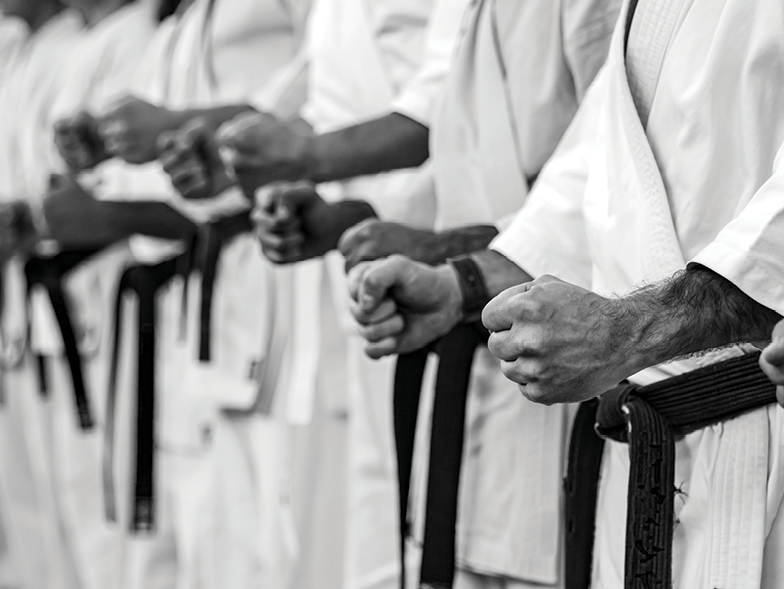How to Be a Black Belt Leader
When John Terry was thirteen, his family relocated from a big city to a small town in Arkansas. Unfortunately, once he got to his new hometown, he became the target of “every bully in school.” He thought his father would talk to the school principal, but, instead, his dad enrolled him in karate classes to learn how to protect himself.

After a while, the bullies stopped bothering Terry, but not because he used his new karate skills to beat them into submission. Instead, his new confidence and leadership abilities from martial arts gave him the strength to approach the bullies and befriend them. “To this day, we are still friends,” Terry says.
Now Terry is the president and CEO of the United States Martial Arts Hall of Fame, a two-time inductee into the hall, and the author of the book Black Belt Leadership 101. He instructs others how to develop the same kind of self-confidence, strength, and leadership to become “black belt leaders,” a self-reflective and empowering process of nine learning exercises that can help those who follow his teachings to transform into better versions of themselves.
The leadership training he provides in his book and online course is imbued with powerful ethics he’s learned during five decades of martial arts. “The martial arts are as much about learning how to live a disciplined life as they are to punch and kick,” he explains. His teachings are predicated on the idea that a big part of leadership involves giving back to those you lead and helping others to become leaders themselves.
“The most important lesson I took from my martial arts journey was learning to lead myself and realizing that the choices I make have consequences in my life,” he says. “If I can learn to lead myself well and make good choices, I have the opportunity for a much better outcome in life. It’s my mission to teach others how to apply the black belt principles I learned to their lives to make a difference.”
Use the guide that follows to develop your own black belt leadership skills.
Belief: The first step to become a black belt leader is developing your confidence and your belief system, Terry says. “You need to believe in yourself, have faith in your abilities, and trust the passion to make the difference you want to make in the world.” If you are a business leader, you may have already started on this leg of your journey.
Learning: Terry is a supporter of lifelong learning. “You need to learn what’s necessary to become a black belt master at whatever your chosen craft, profession, trade, passion, or calling is,” he explains. “You should be a perpetual student.” For instance, he bookends his days with thirty minutes of reading. He suggests reading something inspirational, educational, or biographical. “You should constantly fill your mind with the wisdom, failures, and successes of other people and what they’ve learned.,” he says. Additional ways to do this include taking online courses, hiring a personal coach or mentor, attending conferences, and listening to podcasts.

Accountability: Consider finding someone who can push you on your journey to becoming a black belt leader. “You can hire a mentor or a coach, or it can be someone further along in the journey than you are,” he explains. Also, try to be accountable to yourself and those you lead. “What you say and what you do should be congruent,” he notes. “A leader might expect their employees to clock in at 8:00 a.m., to clock out an hour for lunch, and to clock out promptly at 5:00 p.m. But if they don’t show up until 9:00 a.m. and stroll around drinking coffee, they’re not doing what they expect of others. True leadership models the behavior they want to see in those they are leading.”
Communication. A good leader must communicate well so they can adeptly lead others and share their knowledge. This includes being “an effective listener to hear what people are saying, understand what they are thinking, and know what they need to grow and become a better version of themselves,” he says. Leaders should work on becoming better communicators so people can understand the concept they’re presenting. Consider reaching out to other leaders who can guide you. “Even if someone is just a few steps ahead of you, they have learned things that you haven’t,” Terry explains.
Kinetic: All leaders are people of action. “Leaders are always moving forward, going first, exploring new territory, and doing things that nobody else has done before,” Terry says. “They are the trailblazers.” Sometimes all you need is a boost of confidence to develop that trailblazing ability, just as Terry did so many years ago when he faced his bullies. You could find a mentor to get the inspiration you need, or follow other leaders’ examples.
Boldness: It’s important for a leader to always be on the move and be courageous. “A leader isn’t passive; they are not going to sit on the sidelines,” Terry explains. It’s the job of a leader to effect change. “It’s very easy for an organization to get caught in the trappings of their early success,” he explains. It’s up to a leader to challenge the status quo and strive to be better at who they are and what they do.

Equipping: As a leader, your role isn’t to exalt in your own success—it’s to help others follow your example and become leaders themselves. “You need to equip others with what they need to see success in whatever it is they have been called to do,” Terry says. “If they are going to eventually replace you, you need to pass what you know to them.”
Loyalty: A leader should develop a loyal following and build trust among their followers as well as be loyal to those they are leading. “A leader must be an individual of great character,” Terry stresses. “If they aren’t, they will be a ‘leaderless leader’ because nobody is going to follow them.” A leader should always be serving those they lead and empower them to one day become leaders themselves, he explains.
Transformation: When you progress through all these stages successfully, you will transform into a black belt leader. “If you are spending every day growing yourself and becoming a better version of yourself, over time you will transform,” Terry explains. “Not everybody is going to be a Bruce Lee or Chuck Norris in the ring, but everybody can be a Bruce Lee or Chuck Norris when it comes to learning to discover their own unique gifts so they can become a black belt master at them.”
For more information, visit beablackbeltleader.com


















